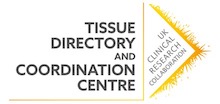NC3Rs Workshop: Human tissue models for cancer research
On 1st and 2nd of March , the UKCRC TDCC attended the NC3Rs workshop: Human tissue models for cancer research. Here, we outline the day’s events and what we learned.
The first day was opened by Prof Gareth Thomas who gave a pathologists perspective, highlighting the importance of the tumour microenvironment which means research should focus on more than studying single cells. He reminded everyone that the classical cancer grading system was not prognostic and that the use of omics technology will provide better insight.
Dr Tony Dickherber from the Innovative Molecular Analysis Technologies (IMAT) Program at the NIH National Cancer Institute, discussed the active IMAT portfolio which included modelling genomics, engineered in vitro models and Bioengineering the tumour microenvironment.
Delegates were encouraged to visit their website and look up research to get ideas and collaborators. A publicly available repository of human cancer cell lines is also available and you can apply for NIH funds – just make sure you leave plenty of time!
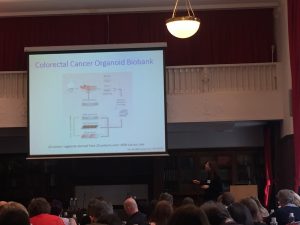
Dr. Hayley Francies talks about next generation of cancel cell
Prof John Greenman from the University of Hull, explained his ‘Tumour on a chip’ and the use of it to keep tumour samples alive for research. 3D bioprinting for brain tumour research was described by Prof. Will Shu, (University of Strathclyde) and Dr Nick Lesley (Heriot-Watt University) and the session was rounded off with an interesting talk on Organoids by Dr. Hayley Francies, from the Wellcome Trust Sanger Institute: ‘Towards the next-generation of cancer cell lines: derivation of an organoid Biobank’ (left).
After lunch John Spaull from GSK, explained where the costs of taking a drug to market come from and highlighted the need to expose drugs to human tissue early, in order to end development if drugs fail. He stated: ‘Why use human tissue? The answer is it works’
John outlined the significance of ethics and consent to the pharmaceutical industry but also bought attention to the importance of standards and data emphasising “without data samples are just a collection”
Dr David Bunton from Reprocell, highlighted that only 1 in 10 new drugs achieve FDA approval and in fact only 1 in 20 cancer drugs pass, indicating that we need better cancer models. Many compounds are also still ineffective in a high percentage of patients. He utilises precision cut slices for research which are organotypic but remain reliant on important factors for tissue culture. His team are using these to dissect precision medicine – for example some patients don’t respond to standard therapies, but his team can stratify based on a high or low response.
Larissa Carnevalli from AstraZeneca, discussed the strategies for selecting relevant PDX models, including taking a genomics approach.
In the afternoon, breakout sessions were held to discuss:
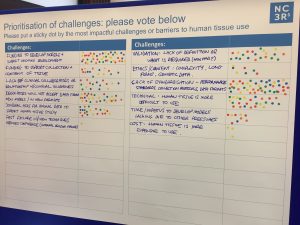
Day 1 discussion
- ‘The state of the art’ which included how tissue is used currently and who are the key players in enabling tissue use
- ‘Defining the challenges’ which included discussing what needs to be done to increase tissue use.
This was followed by a wrap up session and drinks reception, where delegates were given the opportunity to vote on the most pressing issues (right).
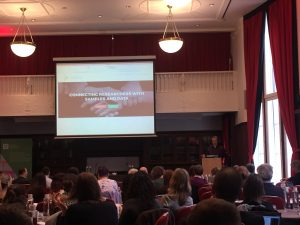
UKCRC TDCC director Dr. Phil Quinlan
Day 2 kicked off with a talk from the UKCRC TDCC director Dr Phil Quinlan, who outlined the role of the centre in tissue access and gave a demonstration of the tissue directory (left). Prof Neil Carragher from the University of Edinburgh discussed drug discovery challenges and pointed out that oncology has one of the worst rates of success from first in man to registration. He outlined an alternative drug discovery pathway and introduced the host and tumour profiling unit at the Edinburgh CRUK Centre.
‘Applying bioinformatics and genomics to reduce animal use in cancer research’ by Dr Christopher Woelk, University of Southampton, outlined issues with data analysis including using deconvolution and the connectivity map. Prof Malcolm Clench, Sheffield Hallam University, followed by discussing Molecular pathology and mass spectrometry imaging in cancer research.
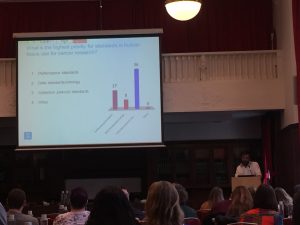
Day 2 discussion
A second breakout session was held to discuss the most popular issues voted from the day before. These included what and who should fund tissue research, standard setting and how technical barriers can be overcome. The workshop highlighted the importance of human tissue to bringing medical research forward, but also the barriers for adoption which included:
- Regulator/publisher acceptance of alternative models.
- Quality standards of human tissue.
- Funding for alternative models.
Let us know if any of these issues are relevant to you and visit the NC3Rs human tissue resource for more.
